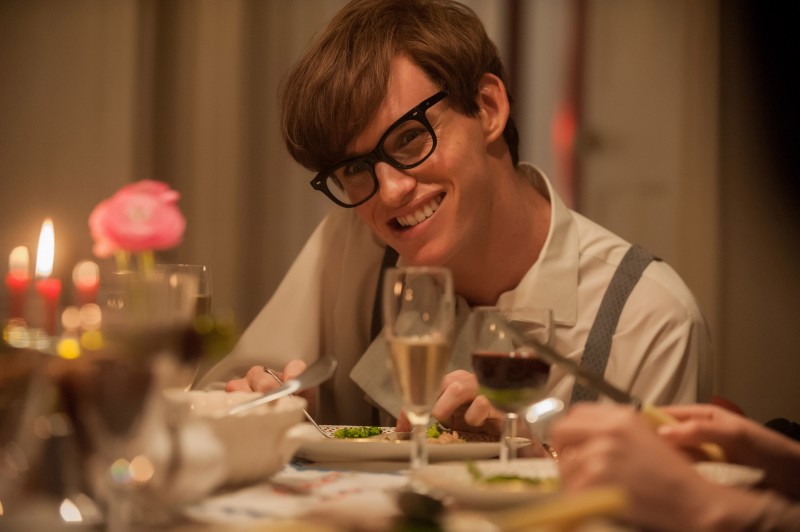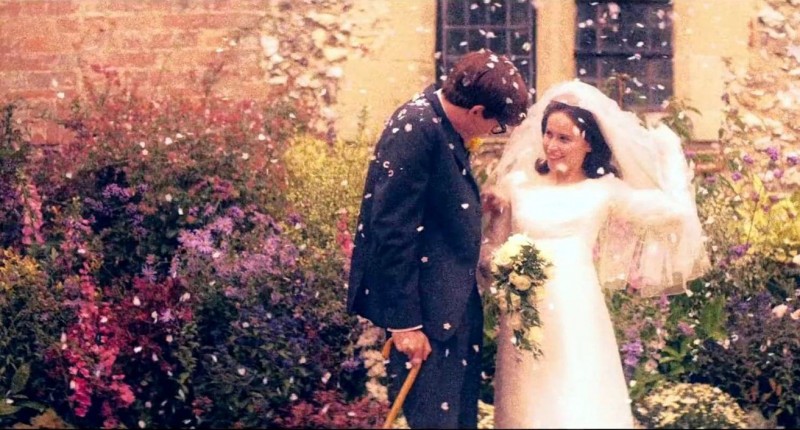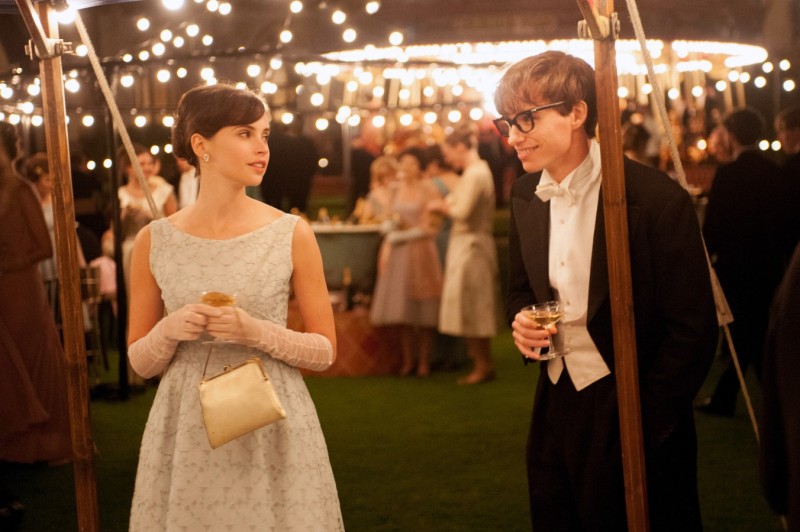The Theory of Everything Review
"A beautifully-acted romance that will make you appreciate everything in your life"
Director James Marsh's love of incredible, real life, stories (
Man on Wire, and
Project Nim come to mind) have lead him to the life of famed black hole physicist, Stephen Hawking. Detailing the two great loves (albeit one more than the other) of the Professor's life,
The Theory of Everything depicts the struggles that accompanied Hawking's progression through motor-neuron disease (ALS), and his desire to quantify the universe.

Beginning in the early 1960's in Cambridge University,
The Theory of Everything sets the stage for a romantic encounter. A couple of college men are walking into a rousing (by 1960's standards at least) party, when they notice a couple of pretty young women. Glances are exchanged, and Stephen (Eddie Redmayne) moves in to “seal the deal.” The girl, Jane (Felicity Jones), becomes mildly impressed with Stephen's intellect, and although he is a staunch atheist (this is a recurring theme), she gives him her number. We come to learn that Stephen is in fact the future Professor Hawking, and through snippets of chalkboard mathematics, that he is indeed a brilliant mind. Shying away from the rest of Hawking's achievements in science,
The Theory of Everything focuses intently on the relationship between Stephen and Jane, and the effects that Stephen's disease has on their love and their family.
Shot like a fairytale romance, James Marsh and cinematographer Benoît Delhomme work tirelessly to achieve this effect. With some help from the magnificent Cambridge University, Marsh and Delhomme only tweak the lighting and filters to heighten the cinematic magic. The medieval-looking architecture of the massive stone buildings surrounded by strands of lights, or lush green croquet fields elevate the romance and the mood of the film. Delhomme shoots much of the more intimate interior shot with the “Barbara Walters” greased filter to warm the light and soften the actor's features. Individually beautiful, these painting-like shots become lost the mass of the narrative and the incredible amount of detail that was put into the film. The production designer, John Paul Kelly did some incredible work stocking the sets with period-specific trinkets, electronics, and minutely detailed furniture – each helping to transport the audience to the ever-changing and very particular time periods.
 The Theory of Everything
The Theory of Everything is sharply focused on the relationship between Stephen and Jane Hawking. Neglecting Stephen's work in astrophysics and cosmology, the film is more interested in the human dynamic of living with such a debilitating disease. Meticulously marking Stephens descent into himself,
The Theory of Everything has a denotation of every major step in his disease's progression. Knowing full well what eventually becomes of Stephen, the audience is left to watch helplessly as the disease takes its toll on the entire Hawking family. With the stresses of caring for Stephen, three growing children, skeptical parents, and Stephen's own intellectual pursuits, the pressures for Jane and tangentially on Steven are immense. In a harrowing scene (and perhaps one of the most profound scenes in recent memory), Stephen, who has been using crutches to get around, stands up to reluctantly get into a wheelchair. As the audience and Stephem both know the eventual outcome, all are held breathless as Dr. Hawking decides to sit down for the last time in his life – relinquishing his ability to stand or move around on his own.

Redmayne and Jones are positively spot-on in their portrayals of the Hawkings. Jones is a perfect emotional match to Redmayne's incredible depiction of young (and eventually old) Stephen. Painstaking research on the behalf of Redmayne led him to an astonishingly accurate portrayal of Stephen Hawking, and one so profound that Hawking himself apparently had trouble telling himself and the actor apart. As the ALS continually destroys his character's ability to control his body, Redmayne is constantly adapting to new physical constraints. The loss of coordination, of speech, and finally, of breathing, Redmayne defeats all with the determination and dignity of someone actually going through the process. Alongside him in his performance, and equally as adaptable, is the vastly talented Jones. Shedding light on the struggle of those who must care for loved ones, Jones balanced the perfect amount of strength and frustration. Unable to cope with what is becoming of her ailing husband, yet equally determined to stay at his side and help him through, Jones' plight is heart wrenching to behold.
A hard-to-watch, yet powerful romance,
The Theory of Everything exists to show just how powerful the bond of love truly is. Partly a biography of the life of Stephen and Jane Hawking, James’s Marsh's film is more solely concerned with its audience more deeply appreciating their lives and the loved ones who inhabit it.
Pros
- Fantastic performances by Redmayne and Jones
- Period accurate setting and set decorations
Cons
- Very standard romance film with little innovation
 Beginning in the early 1960's in Cambridge University, The Theory of Everything sets the stage for a romantic encounter. A couple of college men are walking into a rousing (by 1960's standards at least) party, when they notice a couple of pretty young women. Glances are exchanged, and Stephen (Eddie Redmayne) moves in to “seal the deal.” The girl, Jane (Felicity Jones), becomes mildly impressed with Stephen's intellect, and although he is a staunch atheist (this is a recurring theme), she gives him her number. We come to learn that Stephen is in fact the future Professor Hawking, and through snippets of chalkboard mathematics, that he is indeed a brilliant mind. Shying away from the rest of Hawking's achievements in science, The Theory of Everything focuses intently on the relationship between Stephen and Jane, and the effects that Stephen's disease has on their love and their family.
Shot like a fairytale romance, James Marsh and cinematographer Benoît Delhomme work tirelessly to achieve this effect. With some help from the magnificent Cambridge University, Marsh and Delhomme only tweak the lighting and filters to heighten the cinematic magic. The medieval-looking architecture of the massive stone buildings surrounded by strands of lights, or lush green croquet fields elevate the romance and the mood of the film. Delhomme shoots much of the more intimate interior shot with the “Barbara Walters” greased filter to warm the light and soften the actor's features. Individually beautiful, these painting-like shots become lost the mass of the narrative and the incredible amount of detail that was put into the film. The production designer, John Paul Kelly did some incredible work stocking the sets with period-specific trinkets, electronics, and minutely detailed furniture – each helping to transport the audience to the ever-changing and very particular time periods.
Beginning in the early 1960's in Cambridge University, The Theory of Everything sets the stage for a romantic encounter. A couple of college men are walking into a rousing (by 1960's standards at least) party, when they notice a couple of pretty young women. Glances are exchanged, and Stephen (Eddie Redmayne) moves in to “seal the deal.” The girl, Jane (Felicity Jones), becomes mildly impressed with Stephen's intellect, and although he is a staunch atheist (this is a recurring theme), she gives him her number. We come to learn that Stephen is in fact the future Professor Hawking, and through snippets of chalkboard mathematics, that he is indeed a brilliant mind. Shying away from the rest of Hawking's achievements in science, The Theory of Everything focuses intently on the relationship between Stephen and Jane, and the effects that Stephen's disease has on their love and their family.
Shot like a fairytale romance, James Marsh and cinematographer Benoît Delhomme work tirelessly to achieve this effect. With some help from the magnificent Cambridge University, Marsh and Delhomme only tweak the lighting and filters to heighten the cinematic magic. The medieval-looking architecture of the massive stone buildings surrounded by strands of lights, or lush green croquet fields elevate the romance and the mood of the film. Delhomme shoots much of the more intimate interior shot with the “Barbara Walters” greased filter to warm the light and soften the actor's features. Individually beautiful, these painting-like shots become lost the mass of the narrative and the incredible amount of detail that was put into the film. The production designer, John Paul Kelly did some incredible work stocking the sets with period-specific trinkets, electronics, and minutely detailed furniture – each helping to transport the audience to the ever-changing and very particular time periods.
 The Theory of Everything is sharply focused on the relationship between Stephen and Jane Hawking. Neglecting Stephen's work in astrophysics and cosmology, the film is more interested in the human dynamic of living with such a debilitating disease. Meticulously marking Stephens descent into himself, The Theory of Everything has a denotation of every major step in his disease's progression. Knowing full well what eventually becomes of Stephen, the audience is left to watch helplessly as the disease takes its toll on the entire Hawking family. With the stresses of caring for Stephen, three growing children, skeptical parents, and Stephen's own intellectual pursuits, the pressures for Jane and tangentially on Steven are immense. In a harrowing scene (and perhaps one of the most profound scenes in recent memory), Stephen, who has been using crutches to get around, stands up to reluctantly get into a wheelchair. As the audience and Stephem both know the eventual outcome, all are held breathless as Dr. Hawking decides to sit down for the last time in his life – relinquishing his ability to stand or move around on his own.
The Theory of Everything is sharply focused on the relationship between Stephen and Jane Hawking. Neglecting Stephen's work in astrophysics and cosmology, the film is more interested in the human dynamic of living with such a debilitating disease. Meticulously marking Stephens descent into himself, The Theory of Everything has a denotation of every major step in his disease's progression. Knowing full well what eventually becomes of Stephen, the audience is left to watch helplessly as the disease takes its toll on the entire Hawking family. With the stresses of caring for Stephen, three growing children, skeptical parents, and Stephen's own intellectual pursuits, the pressures for Jane and tangentially on Steven are immense. In a harrowing scene (and perhaps one of the most profound scenes in recent memory), Stephen, who has been using crutches to get around, stands up to reluctantly get into a wheelchair. As the audience and Stephem both know the eventual outcome, all are held breathless as Dr. Hawking decides to sit down for the last time in his life – relinquishing his ability to stand or move around on his own.
 Redmayne and Jones are positively spot-on in their portrayals of the Hawkings. Jones is a perfect emotional match to Redmayne's incredible depiction of young (and eventually old) Stephen. Painstaking research on the behalf of Redmayne led him to an astonishingly accurate portrayal of Stephen Hawking, and one so profound that Hawking himself apparently had trouble telling himself and the actor apart. As the ALS continually destroys his character's ability to control his body, Redmayne is constantly adapting to new physical constraints. The loss of coordination, of speech, and finally, of breathing, Redmayne defeats all with the determination and dignity of someone actually going through the process. Alongside him in his performance, and equally as adaptable, is the vastly talented Jones. Shedding light on the struggle of those who must care for loved ones, Jones balanced the perfect amount of strength and frustration. Unable to cope with what is becoming of her ailing husband, yet equally determined to stay at his side and help him through, Jones' plight is heart wrenching to behold.
A hard-to-watch, yet powerful romance, The Theory of Everything exists to show just how powerful the bond of love truly is. Partly a biography of the life of Stephen and Jane Hawking, James’s Marsh's film is more solely concerned with its audience more deeply appreciating their lives and the loved ones who inhabit it.
Redmayne and Jones are positively spot-on in their portrayals of the Hawkings. Jones is a perfect emotional match to Redmayne's incredible depiction of young (and eventually old) Stephen. Painstaking research on the behalf of Redmayne led him to an astonishingly accurate portrayal of Stephen Hawking, and one so profound that Hawking himself apparently had trouble telling himself and the actor apart. As the ALS continually destroys his character's ability to control his body, Redmayne is constantly adapting to new physical constraints. The loss of coordination, of speech, and finally, of breathing, Redmayne defeats all with the determination and dignity of someone actually going through the process. Alongside him in his performance, and equally as adaptable, is the vastly talented Jones. Shedding light on the struggle of those who must care for loved ones, Jones balanced the perfect amount of strength and frustration. Unable to cope with what is becoming of her ailing husband, yet equally determined to stay at his side and help him through, Jones' plight is heart wrenching to behold.
A hard-to-watch, yet powerful romance, The Theory of Everything exists to show just how powerful the bond of love truly is. Partly a biography of the life of Stephen and Jane Hawking, James’s Marsh's film is more solely concerned with its audience more deeply appreciating their lives and the loved ones who inhabit it.